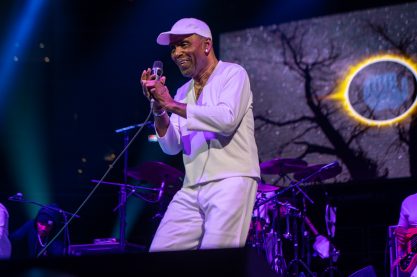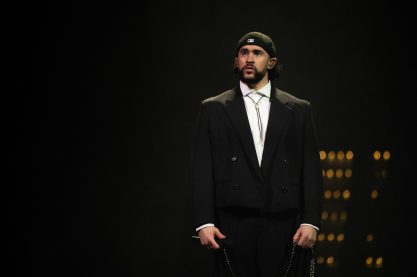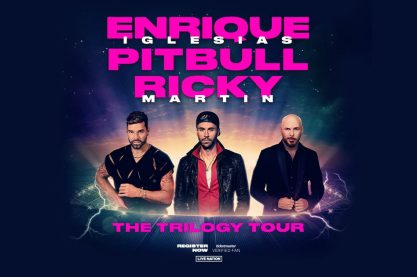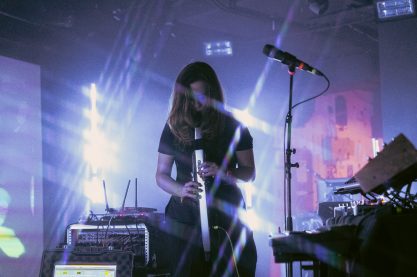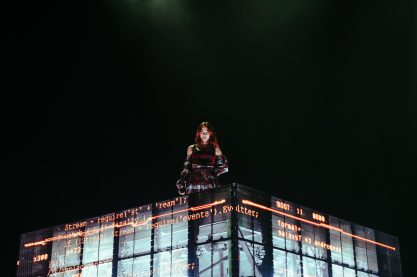Design
UNIVERSAL LANGUAGE, Hip-Hop Dance Exchange, Part II
"Hip-Hop hasn't 'gone global.' It has been global, or international at least, since its birth in the very local neighborhoods of the South Bronx, Washington Heights and Harlem."
~Robin D.G. Kelley, Foreword, The Vinyl Ain't Final: Hip-Hop and the Globalisation of Black Popular Culture
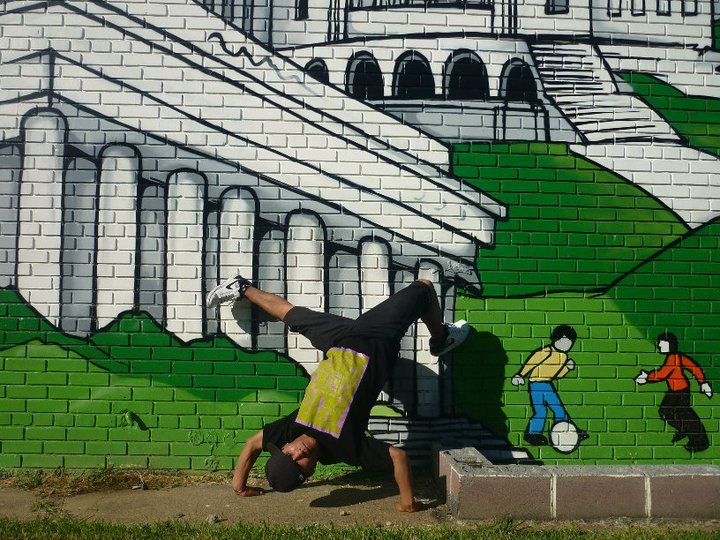
Pictured above: B-boy Crazy Mouse of the Alto Estilo Crew from La Paz, Bolivia in front of WBL's "My DC" mural.
This is the second of three posts about the recent Hip-Hop Dance Exchange co-sponsored by the U.S. Department of State and The John F. Kennedy Center for the Performing Arts (September 30 - October 15, 2010). You can read Part I here. Please share your stories and thoughts in the comments section below.
I am the first to admit it: Hip-Hop is an American folk art. As such, I believe it deserves the respect, acknowledgment, fund$ (yes, I said it. Give us the money!) and professionalism that arts such as jazz, the blues, visual arts and other disciplines enjoy. This is especially true when it comes to future cultural exchanges like the State Department-funded, Kennedy Center-managed, Hip-Hop Dance Exchange I was fortunate enough to lead these past 15 days. However, this does not mean that we can discredit hip-hop's unique and authentically local manifestations abroad.
We see this with the Ugandan emcees' luga flow ("luga" means languages in Lugandan, the dominant language in Uganda) movement, whereby rapping in one's native dialect is encouraged, or in the mash-up dance styles our visitors shared with me--Zeybreak, Bolly hop, and Bhangara-break to name a few. Then, there were those we created together: Burmese and Turkish traditional dances turned into contemporary dance vignettes and fused with ballet, African traditional and contemporary dances combined with breakin' and Turkish movements, Bolivian folk dances and Zimbabwean stepping. And, if you don't believe any of this is possible, just watch the video.
In what I've observed to be the M.O. of most US-driven cultural exchanges, there is an idea that cultural visitors (foreigners) have an empty cup, devoid of any originality. We, benevolent Americans, come to fill this empty cup with our vast knowledge, wisdom and generosity. Please pardon the sarcasm. But, those of us who hold hip-hop's values at our core--those of mutual respect, understanding, competition, love, commUNITY and on & on--know that this is kind of thinking leads only to a dead end when it comes to building for real.
We off that.
And so, my deepest gratitude goes to the hosts of our 8 international b-boys and b-girls these past 15 days, with a special shout out to The John F. Kennedy Center for the Performing Arts, who surprised and impressed me with their sincerity and support for hip-hop culture as a bridge between the seemingly disparate traditions of the 8 nations represented on this trip: Burma, Bolivia, Turkey (Germany), Ecuador, Zimbabwe, Uganda, India and Pakistan. Somewhere between the dwarfing skyscrapers of New York, the 1.8-mile long graffiti pieces along the Raritan River Art Walk, the army of DJs olive Dance Theatre/Rich Medina brought to the West Philadelphia Community Center, and the Kennedy Center rehearsal rooms, we became a family. I am forever grateful to the 8 dancers who challenged me with their own artistic vision and talents, and brought so much love into every experience and dialogue. Indeed, I learned as much or more from them than I could ever hope to offer in return.
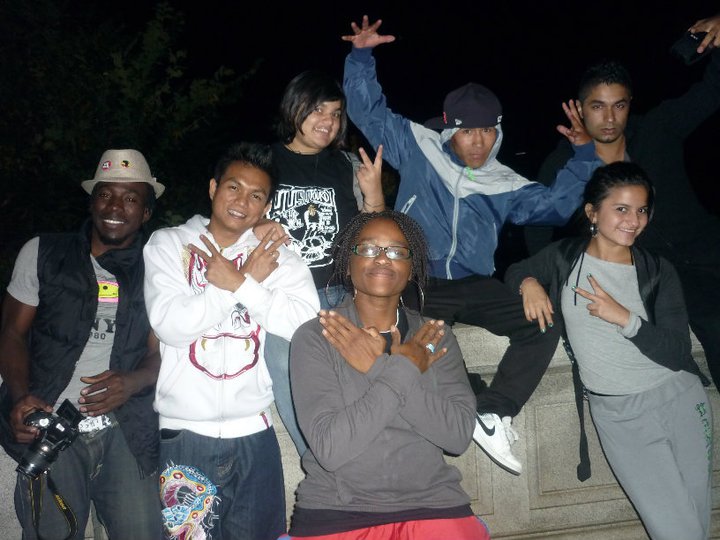
From L to R, top to bottom: B-boy Abdul (Uganda), Min Min Htun (Burma), Nonie Sachdeva (India), B-boy Crazy Mouse (Bolivia), Hasan Rizvi (Pakistan), Yeukai Zinyoro (Zimbabwe) and Hida Jama (Ecuador)
I also had the unique privilege of directing the visitors' final performance at the Kennedy Center's Millennium Stage with DJ EYE AM as our musical director and collaborator. On the "holiday" where we "celebrate" Columbus "discovering" America (okay, you get the point!), the dancers performed for a packed house of enthused guests. Although my name was omitted from the program (Ahem. Me? Salty? Naaa. They still gave me a nod on the mic!) we all experienced growth from a new way of working: emphasis on the process, and not on the product. What you will see in the video of the performance is a multicultural village vibe. A dynamic group of talented, open-minded people with great ideas who formed a lifelong bond. They did this not through language, but with the element of breakin' or b-boyin' as their conduit.
What is sometimes now mistakenly called "hip-hop dance"--I would call it Hip-Hop Contemporary Movement--has taken the art of b-boyin' and infused it with an amalgamation of local rhythms and styles. It is my belief that this "new style" (as our European homies call it) informs and expands our dance vocabulary, and is the contribution of this new generation of performers who embrace hip-hop culture with passion and purpose. As Mare139 so eloquently stated at the Show & Prove Conference at NYU a few weeks back, we must make room for new artists and practitioners who are revolutionizing the art form and culture. The young leaders I met from around the globe are doing just that through movement and music. Let's show our support by shedding bitterness, US cultural superiority, pioneering "I was there"-ness, or "founderitis," a term borrowed from arts management that applies here. Let new energy into the cypher, ya'll. Hip-Hop is a living, breathing thing needing attention, care and innovation.
Will you keep building it up or let your ego cut it down? #jussayin
- - -
ABOUT THE HIP-HOP DANCE EXCHANGE
Since 2006, the U.S. Department of State, Bureau of Educational and Cultural Affairs’ Cultural Visitors program, managed by the DeVos Institute of Arts Management at the Kennedy Center, has offered artistic development and cultural exchange experiences for artists and arts managers. The goal of this program is to energize the work of emerging international artists in their own countries by bringing them to the U.S. and providing them with instructive and informative experiences in their arts discipline, exposure to the creation and performance of world-class American art, and opportunities to develop relationships with U.S. arts professionals. Participants have come from more than 37 countries worldwide, including Azerbaijan, Bolivia, India, Indonesia, Jordan, Kazakhstan, Lebanon, Malaysia, Morocco, and Turkey. On behalf of the U.S. Department of State, the Kennedy Center develops customized programs for each group. For more information visit the Kennedy Center website.
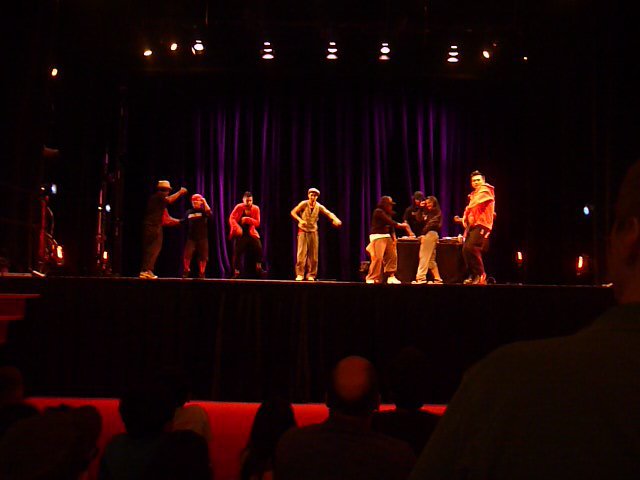
Pictured above: The international cultural visitors performed at the Kennedy Center’s Millennium Stage on Monday, October 11, 2010 at 6:00 p.m. You can watch their extraordinary performance by clicking here.
